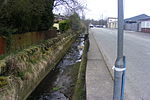Trent Mill
1967 disestablishments in EnglandBuildings and structures demolished in 1967Demolished buildings and structures in Greater ManchesterDemolished manufacturing buildings and structuresFormer textile mills in the United Kingdom ... and 3 more
Shaw and CromptonTextile mills in the Metropolitan Borough of OldhamTextile mills owned by the Lancashire Cotton Corporation
Trent Mill was a cotton spinning mill on Duchess Street in Shaw and Crompton, Greater Manchester, England. It was built by F.W. Dixon & Son in 1908. It closed and was taken over by the Lancashire Cotton Corporation in 1929 reopened in 1938 and closed again in 1962, and was demolished in 1967.
Excerpt from the Wikipedia article Trent Mill (License: CC BY-SA 3.0, Authors).Trent Mill
Trent Road,
Geographical coordinates (GPS) Address Phone number Website Nearby Places Show on map
Geographical coordinates (GPS)
| Latitude | Longitude |
|---|---|
| N 53.5858 ° | E -2.0966 ° |
Address
Rushcroft Primary School
Trent Road
OL2 7YL , Wood End
England, United Kingdom
Open on Google Maps







